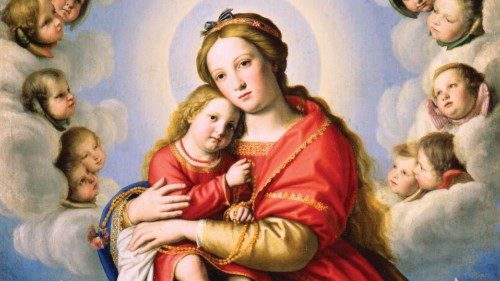Dogmas

The two most recent Marian dogmas (Immaculate Conception and Assumption) have in common an original sin that makes them distant from the life of believers and therefore incapable of consoling them and moving them to love and testimony. This original sin is being thought of in context - and even more so being obsessively conveyed - as privileges concerning Mary, who is described as unique, unattainable, an goddess like. Obviously this is not the meaning of the two dogmas, but this original endeavor has remained imprinted in preaching, devotion and even theology, rendering dogmas incapable of touching lived experiences. Why? because - in the end - the fact that there is a woman who, alone and inimitable, experienced liberation from sin and death does not change our lives much, nor does it console us.
Therefore, the first step to take in order to enjoy the beauty of the Marian dogmas is to remove this precomprehension. Mary is the daughter of Adam, i.e. fully human, the daughter of Zion, so a full member of the Jewish people, and a member of the church, as the Second Vatican Council stated. Everything we preach about her or that the church has understood about her can only start from her real, concrete humanity, equal to ours in every way, as equal to ours is that of Christ, otherwise there is no incarnation and without incarnation there is no Christian hope. Having taken this step, we can go to the dogmas on Mary and reread them in such a way that they nourish our life now, our faith and our commitment.
Let us begin with the dogma of the Assumption. Actually, chronologically, the dogma of the Immaculate Conception (1854) was proclaimed first, and even in the theological arguments that were made, the dogma of the Assumption (1950) is presented as a consequence of the dogma of the Immaculate Conception, because a different experience of death is deduced from the absence of sin in Mary. In spite of this, we commence from the dogma of the Assumption because the reflection and prayer intertwined around Mary’s death are much older than the reflection on her conception, which was mainly the result of medieval speculation and a devotion that in the second Christian millennium had begun a hyper-exaltation of Mary. The dormitio, on the other hand, i.e. the mystery of her death thought of as a serene falling asleep in order to enter immediately and wholly into the life of God, is something that attracted the faith of the church as early as the first centuries.
The “dormitio” became in the dogma proclaimed by Pius XII the Assumption of Mary in body and soul. In doing so, he emphasized the fact that in her there is no corruption of the body and that she - whether she died or not is not known - immediately entered into God’s life and bodily too as soon as her earthly life was over. Admittedly, this way of presenting her death presupposes certain ideas about the human being (e.g. the possible separation of the soul from the body) and about the final fulfilment (e.g. a procrastination of the resurrection of bodies with respect to death) that today’s theology questions. However, the good news remains: Christ’s victory over death is also shared by those who believe in him, starting with Mary, the believer, the first and most perfect of the disciples. In her Assumption we contemplate our destiny, our hope, realised not only in Christ, but already in one of those who have believed in him, who have completed the pilgrimage of faith in which we are still immersed. This it is a woman who already enjoys the fullness of resurrection and that her body has not experienced violence and death is a further reason for liberation. All too often women's bodies are objects of violence and contempt, and many times they are seen as victims only. In Mary's Assumption we contemplate her body untouched by violence, sacrifice, pain, but totally transfigured by life. Each woman now knows that no pain is necessary and that sacrifice is not required of her; each knows that she is made for the fullness of life. As everyone is.
Let us now turn to the dogma of the Immaculate Conception. To do so would require technical clarifications and the introduction of a paradigm shift in the understanding of original sin, which we cannot deal with now, but the good news remains here too. Mary is fully human and it is exactly because of her humanity that she receives the gift of not yielding to evil, therefore receiving a singular fortitude against all sin to the extent that she is never touched by it. This does not happen without her will and she fulfils her freedom, all spent in the love of God and neighbour. The good news is that that same Spirit that worked in her provoking her to this freedom of love has been poured into our hearts. Looking at her we know that sin is not inescapable. She who went through death unharmed imposes on us the hope of a destiny of life too, that is ineluctable. She seems to tell us that she is just a few steps ahead of us, we need only hurry and we will catch up with her.
by SIMONA SEGOLONI
Lecturer in systematic theology













 Purchase the Encyclical here Fratelli Tutti
Purchase the Encyclical here Fratelli Tutti
